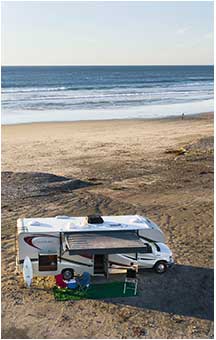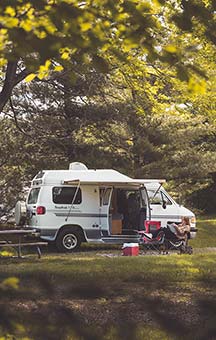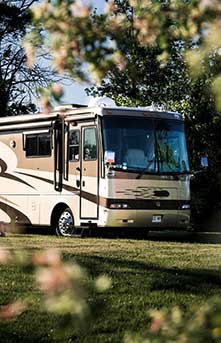Many people love RV motorhomes because they are a home and automobile all in one. They’re often easier to drive than towing a long trailer and don’t require that you also own a truck with a hefty towing capacity. However, one of the biggest advantages can also become one of the biggest drawbacks.
Unless you want to drive a giant bus with less-than-ideal gas mileage around for sightseeing, a motorhome can limit how far you venture from your campsite. It can be difficult to maneuver big rigs through small towns, cities, and rural roads designed for smaller automobiles. Finding an open parking spot that’s long enough can be nearly impossible at times. Even smaller Class C motorhomes face these challenges.
This is why many choose to tow their automobiles behind their motorhome using a tow dolly. But like any similar purchase, you’ll want to be sure to do your research beforehand so you get the best RV tow dolly within your budget.
What is a tow dolly?
If you’re new to RVing, you may be wondering what a tow dolly even is. When it comes to pulling your car behind a motorhome, you have three main options: dolly tow, flat tow, or a car hauler.
A tow dolly is a two-wheeled trailer that you attach to the hitch of your motorhome. You drive the front wheels of your car onto the dolly and secure them with straps, leaving your rear wheels on the ground. These work great with front-wheel drive vehicles and save you from having to detach the drive shaft.
With flat towing, you simply attach your vehicle to the back of your RV and pull it with all four wheels on the ground. There’s no large pieces of equipment required aside from the tow bar that’s used to connect the two. However, not every automobile can be towed this way. Automatic and some manual transmissions can suffer damage if pulled on all four wheels without first detaching the drive shaft.
A car hauler is a trailer that you drive your entire car onto. Your vehicle does not touch the ground. Though these work with all vehicles, they are much larger and heavier than a tow dolly. This can make it too heavy for your RV to pull or impractical for some campers.
What should you consider when buying an RV tow dolly?
While there isn’t a ton of variation in the different tow dollies on the market, there are a few things that you’ll want to keep in mind when making your purchase.
Braking Features
Most RV tow dollies manufactured today feature their own braking system. This ensures that when you put on the brakes, your trailer will also make an effort to stop. If you happen to purchase a used model that doesn’t have brakes, you will need to install auxiliary brakes. Not only does this make towing safer, but it is also required by law in many states.
For more information about trailer brake requirements by state, visit AAA’s webpage on trailer and RV travel.
Electric vs. Surge Brakes
Brakes can be one of two types: electric or surge. Electric brakes require a brake controller in the RV and the associated wiring. This type of braking system is typically more expensive, but with the brake control unit, you have the ability to apply the trailer brakes independent of the towing vehicle.
This feature is helpful in instances where your in-tow vehicle sways, in which applying trailer brakes before the coach brakes can correct the issue.
Surge brakes, on the other hand, are hydraulic. They use the trailer’s momentum to actuate the brakes. These don’t require any hook-up to a separate control unit and are self-contained on the trailer, meaning that the dolly can be towed behind most RVs without any additional work.
Seasoned RV owners may swear by either one, but the decision usually comes down to personal preference.
Types of Dolly Pivots
There are two main types of RV tow dollies: mounted front wheel and center pivot. The difference between the two is the point where the trailer pivots when making a turn. Again, like the brake type, there is not necessarily a “better” pivot type. It all comes down to personal preference.
Dolly and Vehicle Lights
When comparing tow dollies, don’t forget about lights. Not only is towing without lights incredibly dangerous, but it is also illegal in most cases. Both the fenders of your RV tow dolly and the tail lights of your car need to be able to signal to other drivers when you are braking or turning.
Basic models may only have reflectors, meaning you’ll need to purchase a separate lighting system that can be connected to your RV. Others have lighting systems built-in and easily connect to your RV’s system.
The Weight of Your Vehicle
It is recommended that your towing vehicle be 750 pounds heavier than the vehicle-in-tow. Since RVs are much larger than most personal vehicles, this usually isn’t an issue. If you have questions regarding the weight of your RV or vehicle, refer to your owner’s manuals.
Finding the Best Tow Dolly
Choosing the best tow dolly model often comes down to personal preference, your particular RV, the car you’ll be towing, and the conditions you’ll be driving in most often. Before making a decision, search for reviews from other RV owners to learn more about their experiences and set-ups. Trailer dealers are also usually able to answer questions that may be specific to your rig.
Helpful RV Tow Dolly Tips
If using a tow dolly, use these best practices to keep you and those around you safe.
- Always refer to the owner’s manual of both your motorhome and towed vehicle to learn more about towing specifications.
- Unless otherwise instructed, always load your car on facing forward with the front wheels on the dolly. Towing a rear-facing vehicle can cause whipping— a violent and uncontrollable sway of the car in tow.
- Do NOT load cargo inside of your towed vehicle or on the tow dolly. This can also cause whipping.
- When towing, if you notice your vehicle swaying, slow down. Swaying can easily turn into whipping if not gently corrected.
- Save your brakes by downshifting when going downhill, if possible.
Towing or not, always adhere to the local rules of the road and drive defensively. As tempting as it can be to get to the next destination quickly, driving at a safe speed will help ensure that you and your RV arrive in one piece.
Conclusion
RV tow dollies are a great choice for those looking to bring their personal automobiles along with them on a journey. Tow dollies have many advantages over flat towing, but you want to always be sure to check with the specifications of your RV and vehicle before any method is used.






